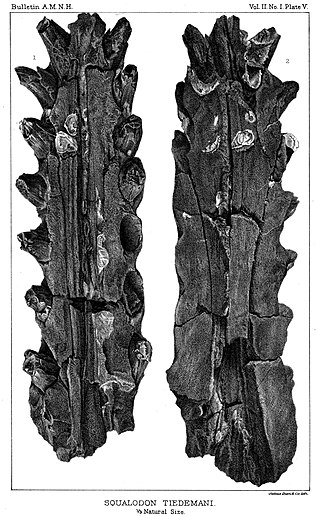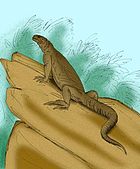
Ceratosaurus was a carnivorous theropod dinosaur that lived in the Late Jurassic period. The genus was first described in 1884 by American paleontologist Othniel Charles Marsh based on a nearly complete skeleton discovered in Garden Park, Colorado, in rocks belonging to the Morrison Formation. The type species is Ceratosaurus nasicornis.

Euoplocephalus is a genus of large herbivorous ankylosaurid dinosaurs, living during the Late Cretaceous of Canada. It has only one named species, Euoplocephalus tutus.

Edmontosaurus, with the second species often colloquially and historically known as Anatosaurus or Anatotitan, is a genus of hadrosaurid (duck-billed) dinosaur. It contains two known species: Edmontosaurus regalis and Edmontosaurus annectens. Fossils of E. regalis have been found in rocks of western North America that date from the late Campanian age of the Cretaceous period 73 million years ago, while those of E. annectens were found in the same geographic region from rocks dated to the end of the Maastrichtian age, 66 million years ago. Edmontosaurus was one of the last non-avian dinosaurs to ever exist, and lived alongside dinosaurs like Triceratops, Tyrannosaurus, Ankylosaurus, and Pachycephalosaurus shortly before the Cretaceous–Paleogene extinction event.

Lambeosaurus is a genus of hadrosaurid dinosaur that lived during the Late Cretaceous period of western North America. The first skull of Lambeosaurus described was used by palaeontologist Lawrence M. Lambe to justify the creation of the new genus Stephanosaurus, but it was shown that this skull had to belong to a separate taxon, which William A. Parks named Lambeosaurus lambei in 1923, to honour Lambe. Multiple further species of Lambeosaurus have been named since, including L. clavinitialis and L. magnicristatus in 1935, and L. laticaudus in 1981 which was later moved to its own genus Magnapaulia. It has also been identified that some of the species of the genera Tetragonosaurus and Corythosaurus are juveniles of Lambeosaurus, including T. praeceps, T. cranibrevis, and C. frontalis. Lambeosaurus is the eponymous member of its subfamily Lambeosaurinae and tribe Lambeosaurini. Lambeosaurins, which also includes Corythosaurus and Hypacrosaurus from western North America, are understood to be some of the most specialized ornithopods.

Paraceratherium is an extinct genus of hornless rhinocerotoids belonging to the family Paraceratheriidae. It is one of the largest terrestrial mammals that has ever existed and lived from the early to late Oligocene epoch. The first fossils were discovered in what is now Pakistan, and remains have been found across Eurasia between China and the Balkans. Paraceratherium means "near the hornless beast", in reference to Aceratherium, the genus in which the type species P. bugtiense was originally placed.

Stegoceras is a genus of pachycephalosaurid (dome-headed) dinosaur that lived in what is now North America during the Late Cretaceous period, about 77.5 to 74 million years ago (mya). The first specimens from Alberta, Canada, were described in 1902, and the type species Stegoceras validum was based on these remains. The generic name means "horn roof", and the specific name means "strong". Several other species have been placed in the genus over the years, but these have since been moved to other genera or deemed junior synonyms. Currently only S. validum and S. novomexicanum, named in 2011 from fossils found in New Mexico, remain. The validity of the latter species has also been debated, and it may not even belong to the genus Stegoceras.
Thescelosaurus is a genus of ornithischian dinosaur that lived during the Late Cretaceous period in western North America. It was named and described in 1913 by the paleontologist Charles W. Gilmore; the type species is T. neglectus. Two other species, T. garbanii and T. assiniboiensis, were named in 1976 and 2011, respectively. Additional species have been suggested but are currently not accepted. Thescelosaurus is the eponymous member of its family, the Thescelosauridae. Thescelosaurids are either considered to be basal ("primitive") ornithopods, or are placed outside of this group within the broader group Neornithischia.

Edmontonia is a genus of panoplosaurin nodosaurid dinosaur from the Late Cretaceous Period. It is part of the Nodosauridae, a family within Ankylosauria. It is named after the Edmonton Formation, the unit of rock where it was found.

Archaeotherium is an extinct genus of entelodont artiodactyl endemic to North America during the Eocene and Oligocene epochs. Archaeotherium fossils are most common in the White River Formation of the Great Plains, but they have also been found in the John Day Basin of Oregon and the Trans-Pecos area of Texas. Archaeotherium's fossils come from North America, between the Priabonian and Rupelian stages of the Eocene and Oligocene. Up to fifteen species of Archaeotherium have been identified, which are divided into three subgenera. One contains the type species, A. mortoni, among others; another contains very large taxa formerly named Megachoerus and Pelonax; and the last contains A. calkinsi.

Prosqualodon is an extinct genus of Early to Middle Miocene cetacean from Argentina, Australia, New Zealand and Venezuela.

Charles Whitney Gilmore was an American paleontologist who gained renown in the early 20th century for his work on vertebrate fossils during his career at the United States National Museum. Gilmore named many dinosaurs in North America and Mongolia, including the Cretaceous sauropod Alamosaurus, Alectrosaurus, Archaeornithomimus, Bactrosaurus, Brachyceratops, Chirostenotes, Mongolosaurus, Parrosaurus, Pinacosaurus, Styracosaurus ovatus and Thescelosaurus.

Australosuchus is an extinct monospecific genus of crocodylian belonging to the subfamily Mekosuchinae. The type and only known species Australosuchus clarkae lived during the Late Oligocene and the Early Miocene in the Lake Eyre Basin of South Australia. It was described in 1991 by Paul Willis and Ralph Molnar from fossil material discovered at Lake Palankarinna.

Aetiocetus is a genus of extinct basal mysticete, or baleen whale that lived 33.9 to 23.03 million years ago, in the Oligocene in the North Pacific ocean, around Japan, Mexico, and Oregon, U.S. It was first described by Douglas Emlong in 1966 and currently contains known four species, A. cotylalveus, A. polydentatus, A. tomitai, and A. weltoni. These whales are remarkable for their retention of teeth and presence of nutrient foramina, indicating that they possessed baleen. Thus, Aetiocetus represents the transition from teeth to baleen in Oligocene mysticetes. Baleen is a highly derived character, or synapomorphy, of mysticetes, and is a keratinous structure that grows from the palate, or roof of the mouth, of the whale. The presence of baleen is inferred from the fossil record in the skull of Aetiocetus. Aetiocetus is known from both sides of the Pacific Ocean: it was first documented in Oregon, United States, but it is also known from Japan and Mexico. The genus is currently constrained to the Northern hemisphere and has little value in biostratigraphic studies of the Oligocene due to its limited occurrences across the Pacific.

Asiatosuchus is an extinct genus of crocodyloid crocodilians that lived in Eurasia during the Paleogene. Many Paleogene crocodilians from Europe and Asia have been attributed to Asiatosuchus since the genus was named in 1940. These species have a generalized crocodilian morphology typified by flat, triangular skulls. The feature that traditionally united these species under the genus Asiatosuchus is a broad connection or symphysis between the two halves of the lower jaw. Recent studies of the evolutionary relationships of early crocodilians along with closer examinations of the morphology of fossil specimens suggest that only the first named species of Asiatosuchus, A. grangeri from the Eocene of Mongolia, belongs in the genus. Most species are now regarded as nomina dubia or "dubious names", meaning that their type specimens lack the unique anatomical features necessary to justify their classification as distinct species. Other species such as "A." germanicus and "A." depressifrons are still considered valid species, but they do not form an evolutionary grouping with A. grangeri that would warrant them being placed together in the genus Asiatosuchus.
The White River Fauna are fossil animals found in the White River Group of South Dakota, North Dakota, Wyoming, Colorado and Nebraska in the United States. In southwest South Dakota and northwest Nebraska, these fossils are characteristic of the White River Badlands, though they can be found far beyond the limits of the White River watershed.
Gilmoremys is an extinct genus of softshell turtle which lived during the late Cretaceous of North Dakota, Montana and Wyoming, United States.

Arktocara is an extinct genus of river dolphin from the Oligocene epoch of Alaska, containing one species, A. yakataga. Having been discovered in 25-million-year-old strata near the 60th parallel north, it is perhaps the oldest-known crown toothed whale and the northmost river dolphin discovered. It was a member of the now-extinct family Allodelphinidae, along with the genera Allodelphis, Goedertius, Ninjadelphis, and Zarhinocetus. It measured approximately 2.26 or 2.28 meters, comparable to its closest living relative, the South Asian river dolphin, which measures 2.4 meters (7.9 ft). However, the animal probably had an elongated beak and neck, so it may have been longer. The animal is known only from a partially preserved skull. Its ecology may have been similar to the modern-day Dall's porpoise, and it may have competed with contemporaneous delphinoids. Its remains were found in the Poul Creek Formation, which has also yielded several mollusk species.

Ankylorhiza is an extinct genus of toothed whale that lived in what is now the United States during the Oligocene epoch, between 29 and 23.5 million years ago. The type and only known species is A. tiedemani, though two fossil skeletons may represent an additional, second species within the genus. Ankylorhiza was about 4.8 meters (16 ft) long, with a long, robust skull bearing conical teeth that were angled forwards at the tip of the snout.
Xiphiorhynchoides is an extinct genus of swordfish from the Oligocene of Austria. Its fossils have been found in the Paisslberg Formation in Tyrol, which is thought to represent a deepwater environment close to the shore. It is the best preserved member of the Xiphiorhynchinae and known from a single species: X. haeringensis. The name derives from the town of Bad Häring.
Aciprion is an extinct genus of lizard from the Middle Oligocene of Colorado, Wyoming and Nebraska. It was named in 1873 by American paleontologist Edward Drinker Cope for a jaw fragment from the Cedar Creek Member of the White River Formation in Colorado, as the binomial A. formosum. Multiple additional specimens have been referred to the genus, including the second species A. majus named by Gilmore in 1928 for a partial skull. However, the differences between A. formosum and A. majus relate to slight size differences, so A. majus is considered a junior synonym of A. formosum. Cope originally named Aciprion as a genus of teiid lizard, but Gilmore reclassified it as a member of Iguanidae.



















